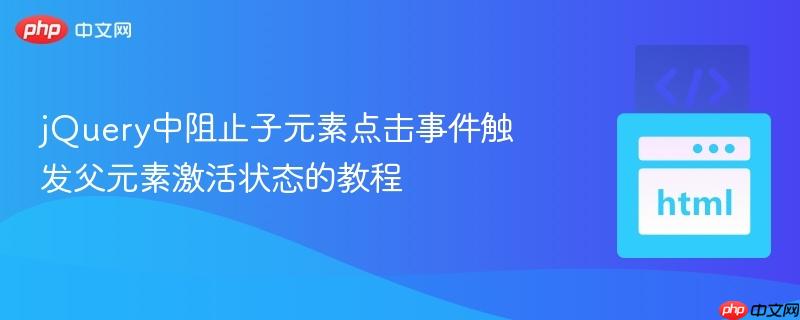
本文旨在解决网页ui设计中常见的父子元素事件冲突问题。当一个父容器(如卡片)被点击时会添加激活样式,但其内部的子元素(如按钮)被点击时不应触发父容器的激活状态。我们将通过介绍事件冒泡机制,并利用jquery的`event.stoppropagation()`方法,提供一个简洁高效的解决方案,确保用户体验的精确控制。
在现代Web应用中,我们经常会遇到包含交互式子元素的父容器。一个典型的场景是,页面上展示了一组服务选项卡片(service-option-card),用户点击卡片时,该卡片会被标记为“激活”状态,通常通过添加一个active CSS类来改变其视觉样式。然而,这些卡片内部可能包含一个“查看详情”或“了解更多”的按钮(service-option-btn),用于打开模态框或导航到新页面。此时,当用户点击这个按钮时,我们不希望父级卡片也随之被激活。
理解事件冒泡机制
要解决这个问题,首先需要理解浏览器中的事件冒泡(Event Bubbling)机制。当一个DOM元素上的事件被触发时(例如,点击一个按钮),该事件首先会在目标元素上执行,然后会沿着DOM树向上“冒泡”,依次触发其父元素、祖父元素,直到document对象。这意味着,如果你点击了卡片内部的按钮,这个点击事件不仅会触发按钮自身的点击处理函数,还会继续向上冒泡,触发卡片上的点击处理函数。这就是为什么点击按钮时,卡片也会被意外激活的原因。
解决方案:阻止事件冒泡
解决此问题的关键在于阻止事件从子元素冒泡到父元素。在jQuery中,我们可以使用event.stopPropagation()方法来实现这一点。当在子元素的事件处理函数中调用event.stopPropagation()时,该事件将停止向上冒泡,从而不会触发其父元素的相同类型事件处理函数。
示例代码与实现
我们通过一个具体的例子来演示如何实现。假设我们有以下HTML结构、CSS样式和初始的jQuery事件处理。
HTML 结构
CSS 样式
以下CSS定义了卡片的布局、边框以及active状态下的背景颜色。
.service-option-container {
margin: 1em 0 4em 0;
display: grid;
grid-template-columns: repeat(3, 1fr);
column-gap: 1em;
row-gap: 1em;
}
.service-option-container .service-option-card {
border: 1px solid black;
border-radius: 20px;
padding: 1em;
margin-left: 1em;
margin-right: 1em;
}
.service-option-container .service-option-card .service-option-btn {
margin: 1em 0;
}
.service-option-container .service-option-card .extra-pad-bottom {
padding-bottom: 2em;
}
.service-option-container .service-option-card .option-price {
font-weight: bold;
}
.service-option-container .service-option-card:hover {
cursor: pointer;
}
.service-option-container .service-option-card.active {
background-color: #efeeee; /* 激活状态背景色 */
}jQuery 事件处理
首先,我们为卡片绑定点击事件,使其在点击时添加active类,并移除其他兄弟卡片的active类。
$(".service-option-card").click(function() {
$(this).addClass("active").siblings('.active').removeClass('active');
});为了阻止点击内部按钮时卡片被激活,我们需要为按钮的点击事件添加event.stopPropagation():
$(".service-option-btn").click(function(e) {
e.stopPropagation(); // 阻止事件冒泡
// 在这里可以添加按钮点击时需要执行的其他逻辑,例如打开模态框
// console.log("Button clicked, card not activated.");
});将以上两段jQuery代码结合起来,完整的JavaScript部分如下:
$(document).ready(function() {
// 卡片点击事件:添加激活类
$(".service-option-card").click(function() {
$(this).addClass("active").siblings('.active').removeClass('active');
});
// 按钮点击事件:阻止冒泡
$(".service-option-btn").click(function(e) {
e.stopPropagation(); // 阻止点击事件向上冒泡到父级卡片
// 在这里执行按钮特有的逻辑,例如显示模态窗口
alert("按钮被点击,卡片不会被激活!");
});
});通过e.stopPropagation(),当用户点击.service-option-btn时,点击事件将不会继续传递到其父元素.service-option-card,因此.service-option-card的点击处理函数就不会被触发,从而避免了不希望的激活状态。
注意事项与总结
- event.stopPropagation()的范围: 它只会阻止事件向上冒泡到父元素,但不会阻止当前元素上其他相同类型的事件处理函数执行,也不会阻止事件捕获阶段(如果存在)的处理。
- event.stopImmediatePropagation(): 如果需要阻止事件冒泡,并且还想阻止当前元素上其他相同类型的事件处理函数(如果有多个绑定在同一个元素上),可以使用event.stopImmediatePropagation()。
- 替代方案:检查event.target: 在某些情况下,你也可以在父元素的点击处理函数中检查event.target(实际被点击的元素)是否是子元素,然后根据情况决定是否执行父元素的逻辑。但对于这种明确需要阻止冒泡的场景,stopPropagation()通常更直接和简洁。
- 用户体验: 精确控制事件行为对于提供良好的用户体验至关重要。避免意外的UI状态变化可以减少用户的困惑。
通过本文的教程,您应该能够理解事件冒泡机制,并掌握如何使用event.stopPropagation()在jQuery中有效地解决父子元素事件冲突的问题,从而实现更精细的UI交互控制。































